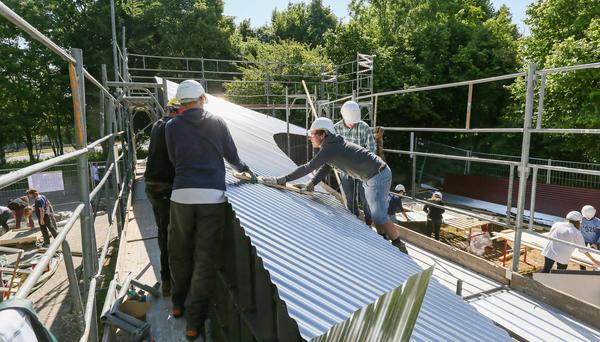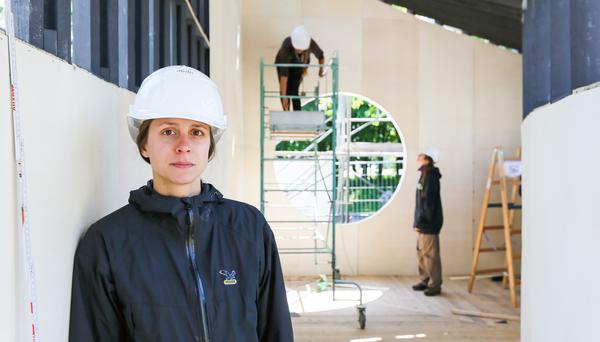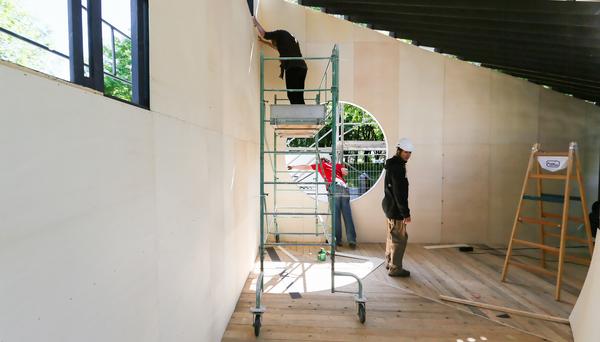The Best Room: from sketch to scaffolding

© 2015 EPFL Alain Herzog
Summer Series on Student Projects: For their Bachelor’s project, architecture students have conceived, designed and built a wooden pavilion that is representative, according to them, of the best room in which to live – and life size!
Victoria Bodevin is in the third year of her Bachelor’s degree in architecture studies, and her project was selected, out of 35 others in her class, to be built on a 1:1  scale. Bodevin dedicated her last semester to the study and realization of an ideal room. Within the EAST laboratory and integrated in research around typologies related to housing, her mission, along with that of her colleagues, was to offer the most pleasant place to live. She took into account multiple parameters such as interior space, materials and functionality. Once the project had been selected, Bodevin also confronted the reality of permit applications, researched the financing and coordinated between the various trades.
scale. Bodevin dedicated her last semester to the study and realization of an ideal room. Within the EAST laboratory and integrated in research around typologies related to housing, her mission, along with that of her colleagues, was to offer the most pleasant place to live. She took into account multiple parameters such as interior space, materials and functionality. Once the project had been selected, Bodevin also confronted the reality of permit applications, researched the financing and coordinated between the various trades.
 As is typical of professional practice, everything begins with a competition. For this one, students were tasked with creating a vision of the ideal room. Bodevin’s concept won over the jury: a curved room which is accessed by a long corridor that opens into an immense space with a ceiling reaching 5 meters high. “When conceiving the design, in order to get the most possible light, we turned the square window into a round opening 2 meters in diameter stretching along the length of the corridor.”
As is typical of professional practice, everything begins with a competition. For this one, students were tasked with creating a vision of the ideal room. Bodevin’s concept won over the jury: a curved room which is accessed by a long corridor that opens into an immense space with a ceiling reaching 5 meters high. “When conceiving the design, in order to get the most possible light, we turned the square window into a round opening 2 meters in diameter stretching along the length of the corridor.”
Once the project had been chosen, students had five weeks to design, draw and optimize their pavilion and just one week to build the it on a 1:1 scale. “At first it was a little messy,” explains Bodevin, “then once the jobs were delegated, it became much more efficient.” Some were part of the design team, others were responsible for construction the roof, walls or framing. They also worked with researchers at the Ibois laboratory who advised them on static aspects as well as the feasibility of their projects.
Martin Fröhlich, head of the Laboratory of Elementary Architecture and Studies of Types (EAST-IA-ENAC), is satisfied with this student experience because it is the first time that students have tackled a semester project on the scale of its actual size. “It gives them a better understanding of the environment in which they will be working. It requires them to pay close attention to every last detail. We can teach them to draw, to design the details, but only real life experience can teach them how to communicate with each other and with various specialists in the field.” These future architects also had to take a safety course before starting to build their Best Room. This allowed them to see the different roles an architect must assume as the key player in any given project.
“My hope is that, when they move on to graduate studies after this Bachelor program, they will have a better idea of their preferred specialization. They can also then deepen their understanding of the concepts they have apprehended here,” concludes Martin Fröhlich.

